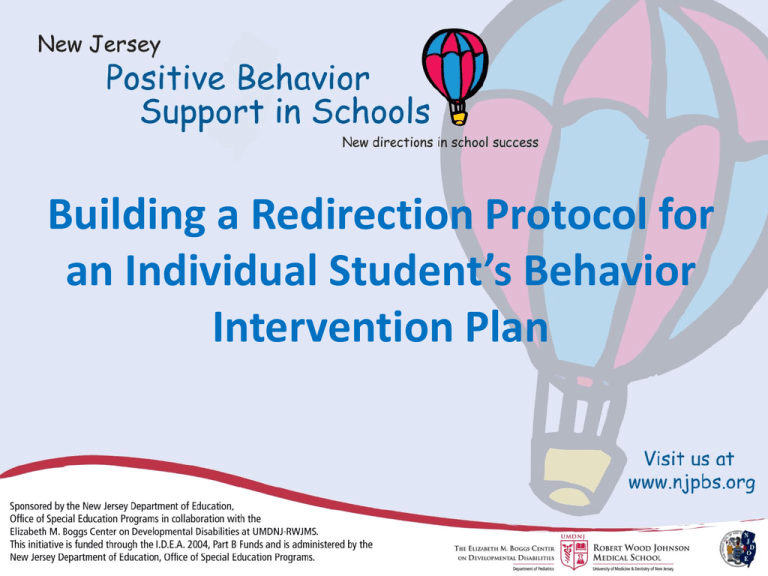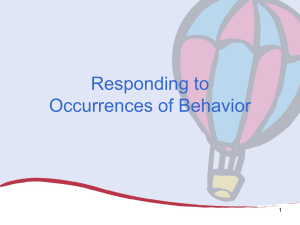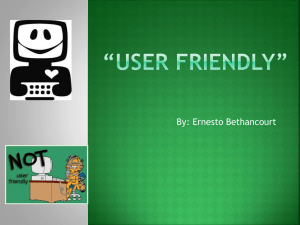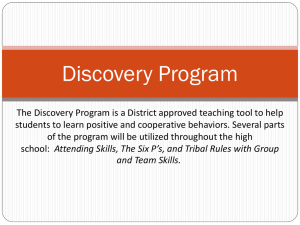Building a Redirection Protocol for an Individual
advertisement

Building a Redirection Protocol for an Individual Student’s Behavior Intervention Plan Group Discussion • Think about a recent situation you observed where a teacher/staff handled a situation really well • Think about a recent situation you observed where a teacher/staff handled a situation poorly Group Discussion • For each situation: – What did the person do that was effective/ineffective? – Was there a difference in the student's response? Developing a Redirection Protocol • A redirection protocol should provide teaching staff with guidance for how to respond when the student displays target behaviors • The protocol should be tailored to what works best for each individual student Developing a Redirection Protocol • Operationalize the student’s behaviors in terms of the escalation sequence and their pace of escalation/recovery – What does the student say & do when they are calm and cooperative – What does the student say & do that signals something is wrong – What does the student say & do the first time a behavior occurs? – What does the student say & do when behavior persists despite redirection strategies Operationalize the Behaviors in Terms of a Response Sequence Calm and Cooperative Follows directions within 20 seconds; engages in tasks; completes tasks; interacts appropriately with teachers and peers; remains in seat Precursor behaviors Pulls out or fiddles with unrelated materials; is noisy with objects (e.g.,. tapping pencil, kicking desk in front of him, flipping binder cover on desk); makes comments that are inappropriate or irrelevant to the situation, makes fun of other students (signals an emerging problem) Initial Occurrence Does not respond to directions provided to the class; will argue with the teacher over directions or corrections; talks to other students when he should be working; has work in front of him but not does not engage in the task; get’s out of seat and walks around the classroom (e.g., stops at other students’ desks, sharpens pencil, looks out window, etc.) Persistent Occurrence Behaviors continues despite redirections; tone of voice gets louder; comments become increasingly inappropriate; ignores teacher Developing a Redirection Protocol • Apply information (e.g., strengths, prior interventions, etc.) learned through the data gathering process to determine those strategies that are the most effective ways to redirect the student back to routine at the precusor, 1st occurrence and persistent occurrence levels of behavior Plan Strategies that Help Staff Attend to an Emerging Situation Scan for signals that the student is having difficulty • As a proactive practice staff should always be attending to facial, body language, tone of voice, compliance signals that indicate a potential problem is emerging • The behavior intervention plan should include a description of key behaviors for the student that indicate a situation is emerging, such as: – – – – – Head down Mumbling Over excited Not following directions Depressed or agitated affect Attend to Emerging Situations When Kevin: pulls out or fiddles with unrelated materials; is noisy with objects (e.g.,. tapping pencil, kicking desk in front of him, flipping binder cover on desk); makes comments that are inappropriate or irrelevant to the situation, makes fun of other students • • • • • State an expectation for the class (e.g., “everyone start the math assignment”) Praise students for being engaged Walk around the classroom to ensure everyone is engaged Approach Kevin and in a quiet private voice ask him if he needs assistance or a minute to get himself together. Use a supportive tone of voice and nondirective language. • State expectation for the situation and have Kevin assess whether he needs help following/meeting the expectation • Provide assistance to get him back engaged in the task • Engage Kevin to generate options or provide Kevin with options to choose from • Offer choices of handling the work assignment or social situation to help re-engage him • Offer a way for Kevin to save face • Remind him of how he can get your attention or help if he needs you • Put a positive spin on the direction or redirection • Provide acknowledgement for positive behavior or choices or effort Check in with Kevin privately if I suspect he is upset or angry. If he is upset or angry • Offer him assistance • Give him some space • Offer an opportunity to collect himself (e.g., go to the bathroom) • Determine if he needs someone to talk to immediately Video Activity Same Situation-Two Approaches • Watch the video clip of Michael – first approach – What are your suggestions for how the teacher could improve her response to Michael? • Watch video clip of Michael – different approach – What did she do this time that you thought was effective Plan Strategies that Help Staff Redirect a First Occurrence of Behavior Plan Strategies to Redirect Behavior • When a behavior occurs first ensure the rest of the class is engaged in an activity • Focus on the majority of the class first (and the individual student second) • Assign an independent, pairs, or small group activity • State an expectation for the class (e.g., “everyone start the math assignment”) • Praise students for being engaged • Walk around the classroom Plan Strategies to Redirect Behavior • Provide staff with student specific strategies that are effective redirectors • • • • • • • • • Speak privately Avoid trying to have the last word Engage the student to generate options Provide the student with options to choose from Use language that focuses on the behavior not the student Be empathetic Acknowledge for positive behavior or choices Give the student some space Change the topic • • • • • • • • • Use humor to defuse and redirect Label the student’s emotion Put a positive spin on your directive Offer a way for the student to save face Appear relaxed Offer a moment to compose or cool down Provide acknowledgement / empathy statements Provide choices Use flexible options Plan Strategies to Redirect Behavior • Plan for academic modifications or adjustments • Sometimes behavior occurs because the students if frustrated by or daunted by the academic work. If you think this might be the case consider ways to make the work more accessible for the student: Plan Strategies to Redirect Behavior • Plan strategies to help teachers adjust academic conditions in response to behavior, for example: • • • • • • • • Changing/modifying the activity Reduce the difficulty of a task Reduce the quantity of work the student is working on at time Provide 1:1 to get started Provide assistance to work through the task Provide the student with a choice of two tasks Ask a peer to help the student Providing assistance to get started Plan Strategies to Redirect Behavior • The plan should indicate strategies or approaches that DON’T work for the student so staff know to avoid using these, for example: • • • • • • • Yelling Scolding a student in front of the class Sarcasm Ultimatums Having the last word Engaging in a debate or argument with the student Using previous incidents as ‘fire power’ Video Activity Same Situation-Two Approaches • Watch the video clip of Sara – first approach – What are your suggestions for how the teacher could improve her response to Sara? • Watch video clip of Sara – different approach – What did she do this time that you thought was effective? Redirect First Occurrence of Behavior • The plan should articulate student specific strategies that staff should use to redirect the first occurrence of behavior. For example: When Kevin: does not respond to class-wide; will argues with the teacher over directions or corrections; talks to other students when he should be working; has work in front of him but not does not engage in the task; get’s out of seat and walks around the classroom (e.g., stops at other students’ desks, sharpens pencil, looks out window, etc.) 1. First praise classmates, make sure everyone else is on task 2. Then address Kevin privately to offer him two choices of how he can handle the situation. Choices may include: a) Continue to try the work or take a break 3. Avoid: a) getting into a power struggle with Kevin, make decisions be his responsibility, b) being confrontational c) getting pulled into a debate about the situation – state the choices available to Kevin, tell him you are giving him a moment to think about it and then walk away and attend to other students Video Activity Same Situation-Two Approaches • Watch the video clip of Jason – first approach – What are your suggestions for how the teacher could improve her response to Jason? • Watch video clip of Jason – different approach – What did she do this time that you thought was effective Plan Strategies that Help Staff Respond to Behavior that Persists Despite Redirections Plan Strategies for When Behavior Persists • Is the behavior disruptive to the class or instruction? – What strategies can the teacher use to re-engage the student into the routine? – Would a break away from class defuse the situation? – Has the behavior escalated to the point that it needs to be office managed? Plan Strategies for When Behavior Persists • Stay calm and cool • Help the teacher to identify their own tolerance limits and form those into strategies – “It really upsets me when…..” • Work with the teacher to identify strategies that help them stay calm and cool – Count to 10 – Deep breath – Etc. Plan Strategies for When Behavior Persists • Reduce Interaction • Give the teacher suggestions for stepping back from a confrontation or disengaging from debate • Reacting to a student’s comments keeps the conflict going – Lower voice – Repeat one phrase (Time to start work) – Offer the student a break to step away Plan Strategies for When Behavior Persists • Pivotal Redirections • Using what is know about ‘what works’ for the student identify those redirection strategies pivotal for responding when behavior persists Plan Strategies for When Behavior Persists • Let’s look at an example for Kevin: If behavior persists and Kevin is not responding to redirections and re-engagement strategies 1. Offer Kevin an out by asking, “Is there something we can do so you can stay in the classroom and be successful?” If he responds sarcastically calmly restate the question once more. 2. If Kevin does not respond appropriately then provide an If, then warning (e.g., If you continue to be disruptive, the consequence is that you will be sent to the office.) 3. If Kevin’s behaviors continue and become unmanageable, send Kevin to the office Plan Strategies for Safety Concerns • Does the behavior place the student or others at risk? – Develop a plan that enables the teacher to get assistance should include • Operationally define the behaviors that constitute an unsafe situation • Who will the teacher get help from? • What should the teacher do with the other students? • What strategies will be used to prevent injury and deescalate? Plan Strategies for Safety Concerns • Ensure that all other prevention and de-escalation strategies discussed have been tried BEFORE making a decision about removing a student from the area • Removing a student from class/setting is a “last resort” measure NOT an intervention strategy • Ultimately, the goal is always for the student to remain in class and benefit from instruction Plan Strategies for Safety Concerns • Determine an appropriate location (e.g., office, guidance, class next door) for the student to go to – Make arrangements with the receiving location prior to implementing the plan – Make arrangements for a possible escort prior to implementing the plan • Determine a safe transition process – Notify key personnel at early sign that the student is having difficult – Determine if the student needs an escort • If yes, contact appropriate personnel for assistance – Contact the receiving office/teacher to notify of student arrival Plan Strategies for Safety Concerns • Determine strategies to assist the student to calm down and return to routine – – – – Ask the student what they need to regroup Provide the student with some private space Engage the student in making a good decision about their behavior Utilize building supports (e.g., counselor or crisis interventionist) to facilitate helping the student to calm down Plan Strategies for Safety Concerns • If a student is removed from class more than 2 times following implementation of the BIP, the team should immediately reconvene to modify and adjust the plan Video Activity • Watch the video clip • Map out the: – Setting events – Antecedents – Behaviors – Consequences • What recommendations would make to this teacher to change how she responded to problem behavior









